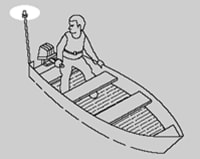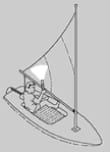Navigation Lights Requirements
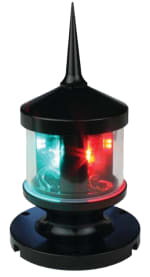 Which Navigation Lights are Required on My Boat?
Which Navigation Lights are Required on My Boat?
Established as a mechanism to avoid collisions at night, navigation lights not only make your boat visible to others at a distance, they also allow an observer to determine your direction of travel relative to themselves, as well as whether you are under power or sail.
If you are new to boating, it's important to know that the USCG has specific requirements that all boats need to meet – often depending on the size of the vessel. Below is a summary of the requirements for navigation lights if you are operating your vessel between sunset and sunrise as well as common compliance issues to keep in mind to avoid a fine.
Please note that each state may have additional laws above and beyond these federal requirements, and we do not go into those here. To ensure compliance with state boating laws, you should contact the appropriate boating agency in your state.
Powerboats:
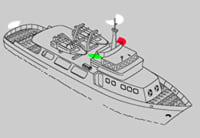 Powerboats less than 164 feet (50 m) but longer than 39.4 feet (12 m)
Powerboats less than 164 feet (50 m) but longer than 39.4 feet (12 m)
While underway – these vessels must display a green sidelight at the starboard side and a red sidelight at the port side. These sidelights should show an unbroken light from dead ahead to 112.5 degrees on either side and should be visible at a distance of 2 nautical miles (NM). Power vessels less than 65.6 ft (20 m) in length may combine the sidelights in a single (“bi-color”) fixture carried on the fore-aft centerline of the boat.
You must also carry an aft facing white stern light, as nearly as practicable at the stern, so its beam is an unbroken arc of 135 degrees showing 67.5 degrees on each side of the vessel (typically mounted on the centerline). This light must also be visible at a distance of 2 NM.
A forward facing white “masthead” light must be carried on the centerline of the boat. Often mounted on a pole or the front of the bridge, the masthead light must show an unbroken beam of 225 degrees (112.5 degrees on either side of the boat) with a visibility of 3 NM, and should not be obscured by any equipment while underway. Not mounted literally at the top of the mast, the masthead light has specific height requirements which depend on the length and beam of the vessel, and place this light higher than the side lights. Refer to your copy of the USCG Navigation Rules and Regulations Handbook (legally required on all boats of this size, and often referred to simply as the “Rules”), Annex I, Section 84 for specific height requirements for your vessel.
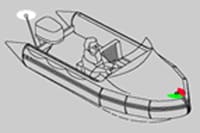 Powerboats less than 39.4 feet (12 meters)
Powerboats less than 39.4 feet (12 meters)
While underway, these vessels must display the same side and stern lights as above, but these lights are only required to have a visibility of 1 NM along with a masthead light with a 2 mile visibility.
On power driven vessels (only) less than 39.4 feet, the masthead and stern functions may be combined into a single all-around white light (225° plus 135°). If used, make sure the all-around white light is at least 3.3 feet (1 meter) above your sidelights. When not underway, this all-round combination light can also be used as an anchor light, see below.
For power boats less than 23 feet (7 meters) that do not exceed 7 knots boat speed, you may display just one all-around white light. However, sidelights are recommended.
Sailboats:
 Sailboats less than 65.6 feet (20 meters)
Sailboats less than 65.6 feet (20 meters)
While under sail, you have several options for displaying navigation lights:
- Display a green light at the starboard side, a red light at the port side (or a bi-color light that combines both), and a white light off your stern – all with the same beam angle and distance visibility requirements as for powerboats, above; or
Display a tri-color light off the top of your mast. This light includes a red light to port, a green light to starboard and a white light aft – all in a single light creating a full circle. This light can only be used when under sail. If under power, or motor-sailing with your sails set, regular navigation lights must be displayed – including a steaming (masthead) light, see below. A tri-color light increases the boat's visibility to others at sea, and can also conserve electrical power when all three lights are illuminated by a single bulb; or
Display a green light off your starboard bow, a red light off your port bow, a white light off your stern with the option to display addition red and green all-round lights at the top of your mast, 1 meter above the uppermost sail. The upper light should be red and the lower light should be green. This option is rarely used today, but is still accepted. Again, the red and green all-round lights at the top of the mast can only be used while under sail.
Visibility of navigation lights for sailboats this size should be as follows:
- Masthead light – 3 NM
- Sidelights/Bi-color light – 2 NM
- Stern or all-round light – 2 NM
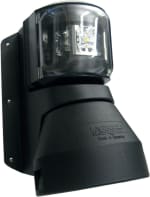
It's also important to note that the function of an all-round white light located at the top of a sailboat mast is an anchor light, not a masthead light. This light should not be used when sailing or powering at night – it should only be used at anchor.
Sailboats less than 23 feet (7 meters)
While under sail, if possible, you should display lights as stated in options 1 or 2 above for the greatest visibility and directional awareness to others. If that is not possible, the Rules state, “the vessel shall exhibit an all-around white light or have ready at hand an electric torch or lighted lantern (flashlight) showing a white light which shall be exhibited in sufficient time to prevent collision.” If you are in this situation, it's best to shine the light against your sail to make the biggest impression possible to avoid collision.
 Anchored Vessels
Anchored Vessels
While it is not technically required for recreational vessels to exhibit an anchor light unless they are outside of a designated anchorage, or anchored in a narrow channel or anchorage where other vessels normally navigate, the Rules state that “a vessel of less than 50 meters in length may exhibit an all-around white light where it can best be seen”.
At Fisheries Supply, we are firm believers that showing an all-around white light at the highest possible point on your vessel is an important safety measure. You never know when another boat might be on the move and will need to see you on a dark night – so why not make it easier on everyone and let them know you are there?
When anchored in a crowded anchorage with its attendant high speed vessel traffic, some skippers opt to show a light at deck level – perhaps a cabin or cockpit light – in addition to their anchor light, to alert speedboat operators who might not notice a light at the top of a tall mast. If you are concerned about the overnight power draw of lights displayed while at anchor, there are now plenty of LED options available – some of which even turn themselves off when the sun comes up.
Potential Compliance Issues for Navigation Lights
The following items are often causes for the issuance of citations by U.S. Coast Guard field inspectors:
On power driven vessels less than 12m (39.4 ft) in length, when choosing the option to replace the masthead and stern lights with a single all round light, the most common problem is that they are mounted on a staff that is too short. Make sure the all-round light is at least 3.3 feet (1 meter) above the sidelights and is high enough to be visible from ahead in spite of the rise of the bow when underway. It should not obscured by equipment or canvas tops - even if this means having to mount it on something longer than 1 meter.
- Sidelights that are mounted on the hull below the gunwale do not meet the International Rules requirement, which requires that they be mounted above the "uppermost continuous deck."
- Inland Rules allow for sidelights mounted on the hull below the gunwale, but they must be visible from dead ahead with the beams not crossed (mounted too far forward) or separated (mounted too far aft). These lights must also be mounted so they are “vertical.”
You can find all the relevant specifications for the navigation lights we sell on the Fisheries Supply website, as well as in our print catalogs. We stock lights from a wide variety of manufacturers, including Aqua Signal, Hella, Lopo Light, NaviSafe, OGM, Perko and Sea-Dog.
If you are simply replacing or upgrading an existing light fixture, your task is relatively straightforward. If, however, you are designing a new installation, you should be forewarned that the complete set of Rules is complex and somewhat difficult to interpret without experience. We urge you to consult a professional to ensure that your installation is both safe and legal.
We hope this helps you determine what you need on your boat, but if not – feel free to contact one of our product experts for clarification at (800) 426-6930.
